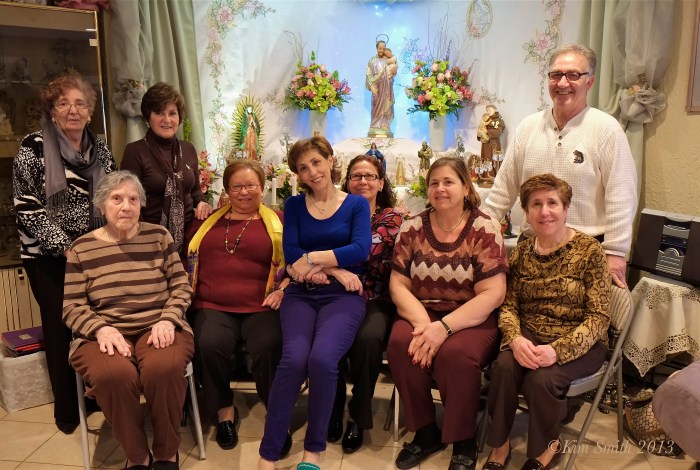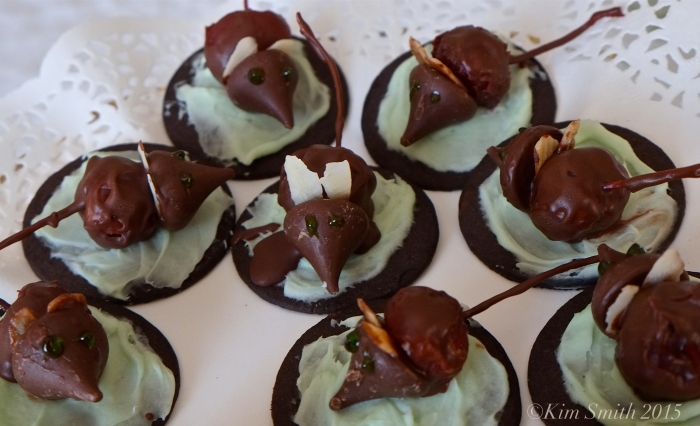Tag: Kathy Pratl
Limoncello Making: Part Two
Last night we strained and bottled (and sampled!) out-of-this-world-delicious limoncello. The first time I had ever tasted limoncello that I found to be enjoyable was while filming at the Groppo Family’s Feast of Saint Joseph celebration. Nina serves her icy cold homemade limoncello in the traditional tiny glasses and I think it is so much better tasting than commercially bottled preparations. The flavor of her limoncello is intensely lemony fresh, sweet, and tart all at the same time, without the alcohol burn on the way down.
The limoncello doesn’t look that appetizing in the pre-bottled stage.
As part of the film’s sequence on Feast preparations, Nina and friends Cathy Gunn, Kathy Pratl, and Jane Beddus very graciously agreed to allow me to film during the different steps of limocello-making, along with inviting me to participate and make my own batch! Nina and her family and friends have been so wonderfully helpful and accommodating with Gloucester’s Feast of Saint Joseph Community Film Project and I will be eternally grateful. Making limoncello with these sweet ladies has been so much fun and a wonderful reminder of the delight and joy that comes from sharing a project with friends.
Catherine Gunn, Nina Groppo, Janer Beddus, and Kathy Pratl
After bottling, we sampled each other’s batches, the reason being that they were all made in slightly different ways; several types of lemons were used, some had more vodka, and some had more simple syrup. Kathy pointed out that the because the recipe is so super simple, the only real error in making would be if you were to grate the lemons to close to the pith, which would make the beverage bitter.
Needless to say, we had a ball sampling all, as well as indulging in the beautiful array of cookies and treats prepared by Nina. To see more photos visit Jane Beddus’s FB page here.
The sieve we found to be the easiest and most effective for straining the pulp was a simple wooden flour sifter, used with cheese cloth, that Nina had purchased in Italy (see below in the Vine).
 Nina served hot, freshly roasted chestnuts. To remove the shell, simply give the chestnut a slight whack. The nut opens and the meat is easily removed by hand.
Nina served hot, freshly roasted chestnuts. To remove the shell, simply give the chestnut a slight whack. The nut opens and the meat is easily removed by hand.
Making Limoncello with Friends and Nina Groppo’s Cucuzza
Left to right, front: Nina Groppo and Kathy Pratl; back: Jane Beddus and Catherine Gunn
 This past weekend filming continued on the Feast of Saint Joseph Community Film Project. Nina and Frank Groppo serve the most wonderful homemade limoncello during the Feast and we decided back in March to include limoncello-making in the story of how Saint Joseph’s special day is celebrated in Gloucester. Nina, Kathy, Catherine, and Jane not only graciously agreed to allow filming, but also included me in the preparations and you’ll see what fun we had in the forthcoming film!
This past weekend filming continued on the Feast of Saint Joseph Community Film Project. Nina and Frank Groppo serve the most wonderful homemade limoncello during the Feast and we decided back in March to include limoncello-making in the story of how Saint Joseph’s special day is celebrated in Gloucester. Nina, Kathy, Catherine, and Jane not only graciously agreed to allow filming, but also included me in the preparations and you’ll see what fun we had in the forthcoming film!
While at the Groppo’s garden you can’t help but notice their amazing crop of cucuzza (pronounced ku-koz-za, also goo-gootz), hanging from their handmade arbor. Cucuzza is an Italian squash that from what I understand, in English, means something like “super long squash.” A single squash can grow ten inches in one day!
For our first of several limoncello-making days, Nina created a beautiful lunch. She served cucuzza soup, made from both the fruit and the leaves. It was fabulous and delicious and like no other soup I had sampled before. She also baked wonderfully fresh hake filets and prepared a lovely tomato salad, with heirloom tomatoes from her garden.
Nina described how she hand pollinates the fruit ~ Each plant produces male and female flowers. She explains that it is easy to identify the female flowers as they have a small swollen fruit (ovary) on the stem, just behind the flowers. She plucks the male flowers off the vine and gently brushes together the male’s anther and female’s stigma, the flower’s reproduction parts, which insures good pollination. By removing the male flowers from the vine, you are not eliminating any potential fruit because the male flowers don’t bear fruit.
I have been planning an arbor for my garden patio for sometime and after seeing and tasting the Groppo’s fabulous cucuzza, I am not waiting any longer to build one!
Thank you dear Nina, Kathy, Catherine, and Jane for your continuing help with the Saint Joseph Film Project!
Nina and Frank Groppo Family
Many, many thanks and our deepest appreciation to the Frank and Nina Groppo Family for agreeing to be interviewed and for allowing us to film their beautiful St. Joseph celebrations. While interviewing and during the feast, their wonderful home was overflowing with family and friends, joy and grace. Thank you Groppo Family and Friends!
 Left to right back row: Vincenza Ferrara, Kathy Pratl, and Francesco Groppo.
Left to right back row: Vincenza Ferrara, Kathy Pratl, and Francesco Groppo.
Left to right front row: Eleonora D’Angelo, Angela Sanfilippo, Agata Groppo, Fina Briguglio, and Maria Sanfilippo.
and Nina “Crocetta” Groppo sitting on Agata’s lap.
Click portrait to view full size image.








